Pore-Scale Mechanism Analysis of Enhanced Oil Recovery by Horizontal Well, Dissolver, Nitrogen, and Steam Combined Flooding in Reducer Systems with Different Viscosities for Heavy Oil Thermal Recovery
Abstract
:1. Introduction
2. Materials and Methods
2.1. Experimental Material
2.2. Emulsification and Viscosity Reduction Experiment
2.3. Two-Dimensional Microscopic Seepage Experiment
3. Results
3.1. The Mechanical Characteristics of the Interface between Multiphase Fluid and Heavy Oil
3.2. Two-Dimensional Microscopic Multiphase Seepage Characteristics
4. Discussion
4.1. Oil Displacement Mechanism of Each Slug in HDNS Combined Flooding
4.2. The Interaction of Each Slug in HDNS Combined Flooding
4.3. Pore-Scale Viscosity Reduction Mechanism of Different Viscosity Reducers
5. Conclusions
Author Contributions
Funding
Data Availability Statement
Conflicts of Interest
References
- Wang, X.; Wang, J.; Qiao, M. Horizontal well, nitrogen and viscosity reducer assisted steam huff and puff technology Taking super heavy oil in shallow and thin beds, Chunfeng Oilfield, Junggar Basin, NW China, as an example. Pet. Explor. Dev. 2013, 40, 104–110. [Google Scholar] [CrossRef]
- Sun, R.; Sun, Y.; Fan, K.; Yang, S.; Qiao, M.; Wang, X.; Yang, Y. Experiment Studies on Horizontal well—N2—Viscosity Depressant—Steam Stimulation for Shallow Thin Super-Heavy Oil Reservoirs. In Proceedings of the SPE Trinidad and Tobago Section Energy Resources Conference, Port of Spain, Trinidad and Tobago, 25–26 June 2018. SPE-191252-MS. [Google Scholar]
- Shi, W.; Ma, Y.; Tao, L.; Zhang, N.; Ma, C.; Bai, J.; Xu, Z.; Zhu, Q.; Zhong, Y. Study of the enhanced oil recovery mechanism and remaining oil state of heavy oil after viscosity-reducer-assisted CO2 foam flooding: 2D microvisualization experimental case. Energy Fuels 2023, 37, 18620–18631. [Google Scholar] [CrossRef]
- Du, Q.; Liu, H.; Wu, G.; Hou, J.; Zhou, K.; Liu, Y. Application of flue-gas foam in thermal-chemical flooding for medium-depth heavy oil reservoirs. Energy Sci. Eng. 2019, 7, 2936–2949. [Google Scholar] [CrossRef]
- Liu, Y.; Zhang, C.; Li, S.; Li, Z. Study of steam heat transfer enhanced by CO2 and chemical agents: In heavy oil production. Pet. Sci. 2023, 20, 1030–1043. [Google Scholar] [CrossRef]
- Pu, W.; Gao, H.; Li, Y.; Luo, Q. Performance and mechanisms of enhanced oil recovery via CO2 assisted steam flooding technique in high heterogeneity heavy oil reservoir: PVT and 3D experimental studies. Pet. Sci. Technol. 2020, 38, 823–835. [Google Scholar] [CrossRef]
- Li, S.; Peng, D.; Feng, S.; Wang, Z.; Zhang, K. Dimethyl ether-steam assisted gravity drainage: Physical 2D heavy oil simulation. Fuel 2023, 342, 127821. [Google Scholar] [CrossRef]
- Huang, S.; Chen, X.; Liu, H.; Xia, Y.; Jiang, J.; Cao, M.; Li, A.; Yang, M. Experimental and numerical study of steam-chamber evolution during solvent-enhanced steam flooding in thin heavy-oil reservoirs. J. Pet. Sci. Eng. 2019, 172, 776–786. [Google Scholar] [CrossRef]
- Huang, Y.; Xiao, W.; Chen, S.; Li, B.; Du, L.; Li, B. A Study on the Adaptability of Nonhydrocarbon Gas-Assisted Steam Flooding to the Development of Heavy Oil Reservoirs. Energies 2022, 15, 4805. [Google Scholar] [CrossRef]
- Du, L.; Li, B.; Ji, Y.; Gai, P.; Lu, T.; Li, B.; Wang, J. A novel strategy to improve steam heat utilization and reduce carbon emissions during heavy oil development. Energy 2023, 266, 126328. [Google Scholar] [CrossRef]
- Pang, Z.; Hong, Q.; Liu, D.; Wang, B. The macro and micro analysis on EOR mechanisms during steam and solvent thermal recovery in heavy oil reservoirs. Geoenergy Sci. Eng. 2023, 230, 212244. [Google Scholar] [CrossRef]
- Wang, Y.; Liu, H.; Zhang, Q.; Chen, Z.; Wang, J.; Dong, X.; Chen, F. Pore-scale experimental study on EOR mechanisms of combining thermal and chemical flooding in heavy oil reservoirs. J. Pet. Sci. Eng. 2020, 185, 106649. [Google Scholar] [CrossRef]
- Mohammadzadeh, O.; Rezaei, N.; Chatzis, I. Pore-Level investigation of heavy oil and bitumen recovery using solvent—Aided steam assisted gravity drainage (SA-SAGD) process. Energy Fuels 2010, 24, 6327–6345. [Google Scholar] [CrossRef]
- Lyu, X. Visualized study of thermochemistry assisted steam flooding to improve oil recovery in heavy oil reservoir with glass micromodels. Fuel 2018, 218, 118–126. [Google Scholar] [CrossRef]
- Yu, X.; Ma, T.; Li, G.; Wang, W.; Song, Z. Pore-scale flooding experiments reveal the thermally regulated flow fields of the curdlan solution. Phys. Fluids 2024, 36, 062010. [Google Scholar] [CrossRef]
- Yang, X.; Zhao, H.; Zhang, B.; Zhao, Q.; Cheng, Y.; Zhang, Y.; Li, Y. Displacement characteristics and produced oil properties in steam flood heavy oil process. Energies 2022, 15, 6246. [Google Scholar] [CrossRef]
- Wu, Z.; Wang, L.; Xie, C.; Yang, W. Experimental investigation on improved heavy oil recovery by air assisted steam injection with 2D visualized models. Fuel 2019, 252, 109–115. [Google Scholar] [CrossRef]
- Pei, H.; Zheng, J.; Zhang, G.; Zhang, J.; Zhao, J. Combination of nano-bentonite stabilized foam and ultra-low IFT surfactant additives assisted steam injection to enhanced heavy oil recovery. J. Mol. Liq. 2022, 368, 120647. [Google Scholar] [CrossRef]
- Borisov, D.N.; Tazeev, D.I.; Milordov, D.V.; Mironov, N.A.; Borisova, Y.Y.; Yakubov, M.R.; Beregovoy, A.N.; Amerkhanov, M.I.; Khisamov, R.S. Physical modeling of the composite solvent injection to improve the ultra-viscous oil recovery efficiency steam-assisted gravity drainage. J. Pet. Sci. Eng. 2018, 169, 337–343. [Google Scholar] [CrossRef]
- Liu, W.; Du, L.; Zou, X.; Liu, T.; Wu, X.; Wang, Y.; Dong, J. Experimental study on the enhanced ultra-heavy oil recovery using an oil-soluble viscosity reducer and CO2 assisted steam flooding. Geoenergy Sci. Eng. 2023, 222, 211409. [Google Scholar] [CrossRef]
- Kar, T.; Hascakir, B. Effect of solvent type on emulsion formation in steam and solvent-steam flooding processes for heavy oil recovery. Colloids Surf. A Physicochem. Eng. Asp. 2021, 611, 125783. [Google Scholar] [CrossRef]
- Fan, J.; Shi, J.; Yang, J.; Jin, B. Experimental study on the mechanism of enhanced oil recovery by air assisted cyclic steam stimulation process in extra-heavy oil reservoirs. Energy Sources Part A Recovery Util. Environ. Eff. 2019, 44, 4902–4916. [Google Scholar] [CrossRef]
- Qin, J.; Zhang, J.; Zhu, S.; Wang, Y.; Wan, T. Multi-Component thermal fluid injection performance in recovery of heavy oil reservoirs. Front. Energy Res. 2021, 9, 803540. [Google Scholar] [CrossRef]
- Li, Y.; Liu, H.; Wang, W.; Loh, W.L.; Lyu, X.; Li, X.; Peng, C.; Peng, H. Microvisual investigation on steam-assisted heavy oil extraction behavior in heterogeneous porous media. Energy Fuels 2023, 37, 11776–11786. [Google Scholar] [CrossRef]
- Wu, B.; Gao, J. A viscosity reduction study on chinese extra heavy oil by the addition of synthesized novel oil-soluble viscosity-reducing agents. Pet. Sci. Technol. 2010, 28, 1919–1935. [Google Scholar] [CrossRef]
- Li, S.; Han, R.; Wang, Q.; Wei, X. Visual Flooding Experiment of Hot Water, Steam and Solvent under SAGD. In Proceedings of the ASME 2021 40th International Conference on Ocean, Offshore and Arctic Engineering, New York, NY, USA, 21–30 June 2021. [Google Scholar]
- Wang, Z.; Du, H.; Li, S.; Li, S. Experimental study on gas-assisted cyclic steam stimulation under heavy-oil sandstone reservoir conditions: Effect of N2/CO2 ratio and foaming agent. Geoenergy Sci. Eng. 2023, 228, 211976. [Google Scholar] [CrossRef]
- Tao, L.; Yuan, X.; Huang, S.; Liu, N.; Zhang, N.; Li, B. 3D experimental investigation on enhanced oil recovery by flue gas assisted steam assisted gravity drainage. Energy Explor. Exploit. 2021, 39, 1162–1183. [Google Scholar] [CrossRef]
- Zhang, N.; Liu, W.; Zou, X.; Wang, S.; Sun, Q.; Li, B.; Li, S.; Bhusal, A.; Wang, S.; Li, Z. Experimental study on thermochemical composite system huff-n-puff process in ultra-heavy oil production. Fuel 2023, 332, 126014. [Google Scholar] [CrossRef]
- Li, Z.; Bai, S. Insights into enhanced oil recovery by coupling branched-preformed particle gel and viscosity reducer flooding in ordinary heavy oil reservoir. Geofluids 2023, 2023, 9357711. [Google Scholar] [CrossRef]
- Zhai, M.; Du, Q.; Liu, Y.; Wu, G.; Sun, J.; Sha, Y.; Hou, J. Potential of a new water-soluble agent for enhancing heavy oil recovery: A pore-scale investigation. J. Pet. Sci. Eng. 2022, 208, 109646. [Google Scholar] [CrossRef]
- Guo, J.; Wang, H.; Chen, C.; Chen, Y.; Xie, X. Synthesis and evaluation of an oil-soluble viscosity reducer for heavy oil. Pet. Sci. 2010, 7, 536–540. [Google Scholar] [CrossRef]
- Mao, J.; Liu, J.; Peng, Y.; Zhang, Z.; Zhao, J. Quadripolymers as viscosity reducers for heavy oil. Energy Fuels 2017, 32, 119–124. [Google Scholar] [CrossRef]
- Zhang, Z.; Wang, Y.; Ding, M.; Mao, D.; Chen, M.; Han, Y.; Liu, Y.; Xue, X. Effects of viscosification, ultra-low interfacial tension, and emulsification on heavy oil recovery by combination flooding. J. Mol. Liq. 2023, 380, 121698. [Google Scholar] [CrossRef]
- Wu, Z.; Liu, H.; Wang, X. Adaptability research of thermal–chemical assisted steam injection in heavy oil reservoirs. J. Energy Resour. Technol. 2018, 140, 052901. [Google Scholar]
- Razavifar, M.; Qajar, J.; Riazi, M. Experimental study on pore-scale mechanisms of ultrasonic-assisted heavy oil recovery with solvent effects. J. Pet. Sci. Eng. 2022, 214, 110503. [Google Scholar] [CrossRef]
- Qi, Z.; Abedini, A.; Lele, P.; Mosavat, N.; Guerrero, A.; Sinton, D. Pore-scale analysis of condensing solvent bitumen extraction. Fuel 2017, 193, 284–293. [Google Scholar] [CrossRef]
- Xu, L.; Abedini, A.; Qi, Z.; Kim, M.; Guerrero, A.; Sinton, D. Pore-scale analysis of steam-solvent coinjection: Azeotropic temperature, dilution and asphaltene deposition. Fuel 2018, 220, 151–158. [Google Scholar] [CrossRef]
- Qi, Z.; Abedini, A.; Sharbatian, A.; Pang, Y.; Guerrero, A.; Sinton, D. Asphaltene deposition during bitumen extraction with natural gas condensate and naphtha. Energy Fuels 2018, 32, 1433–1439. [Google Scholar] [CrossRef]
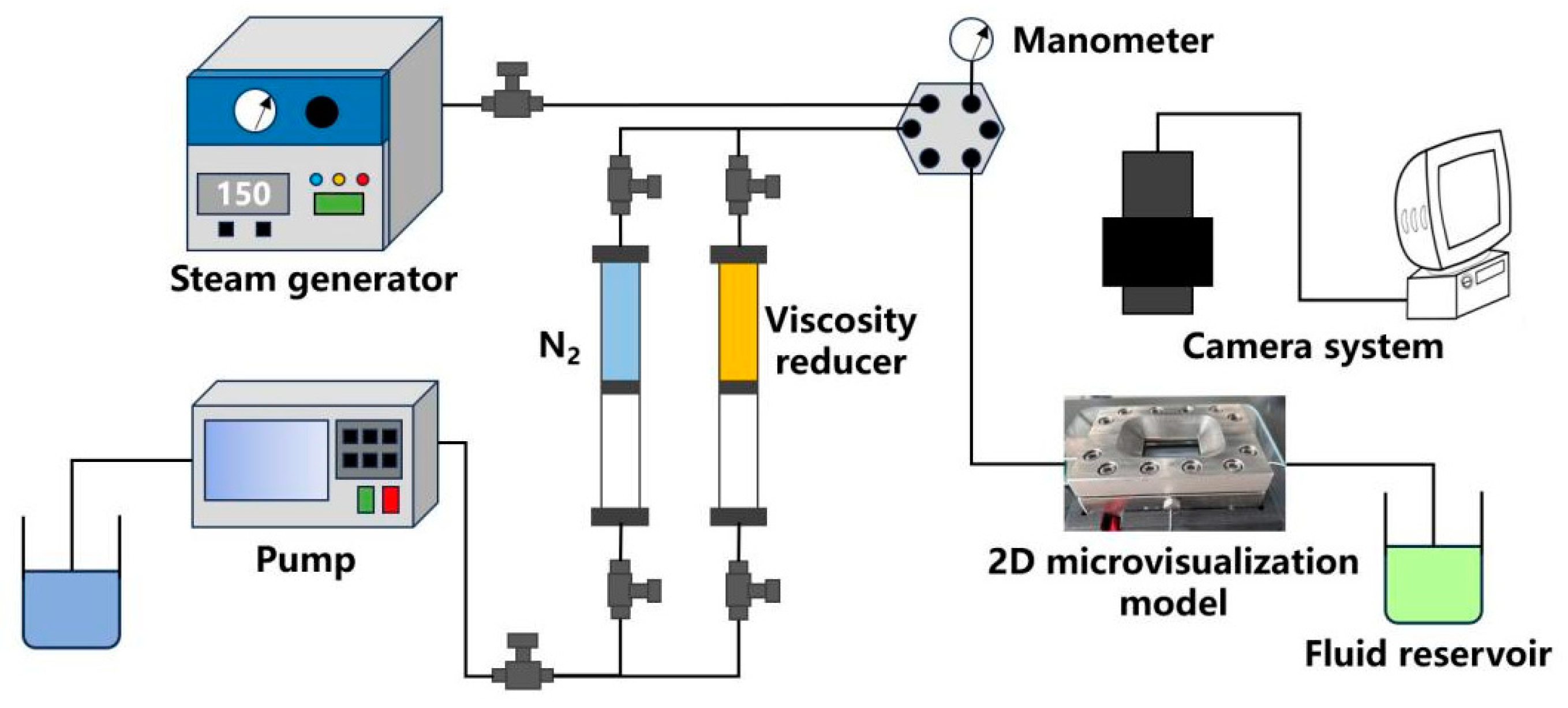



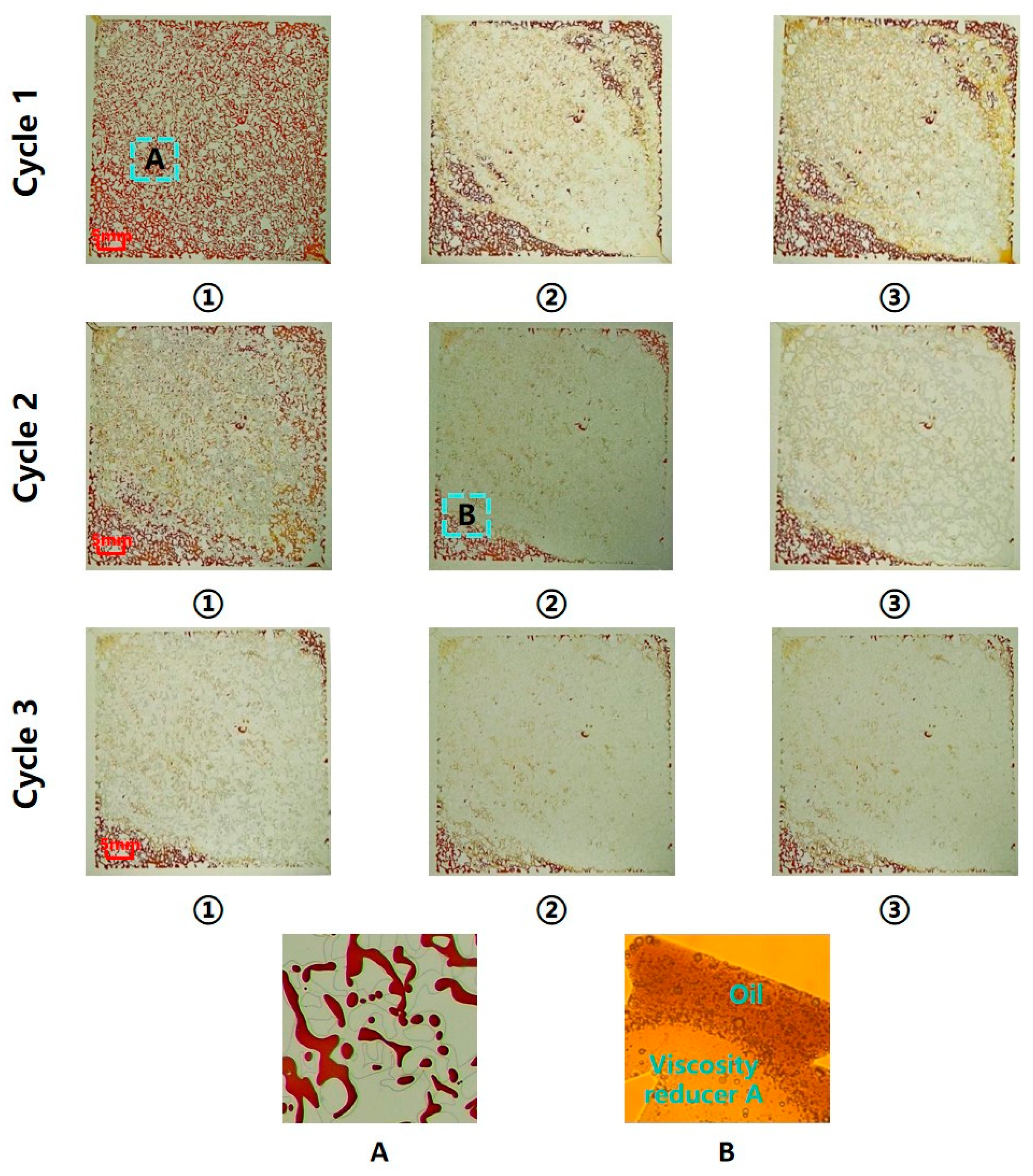
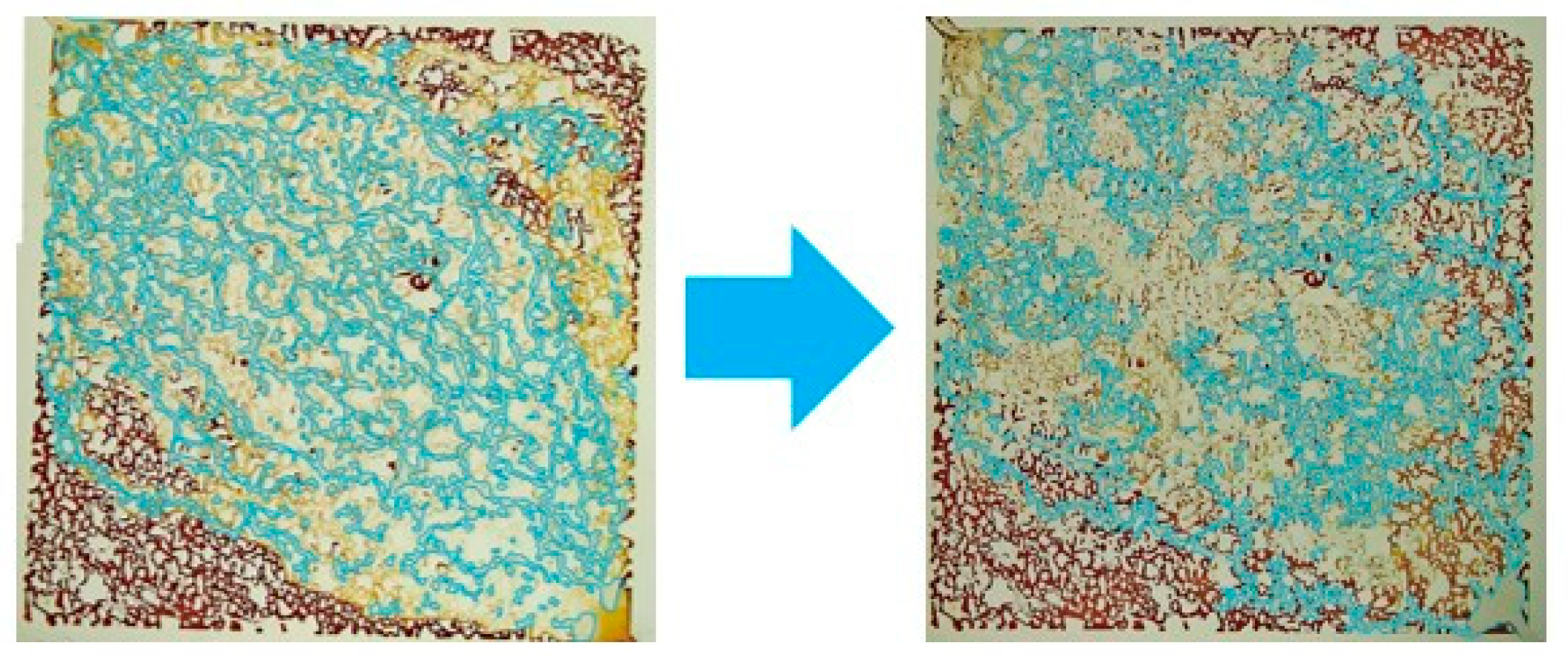
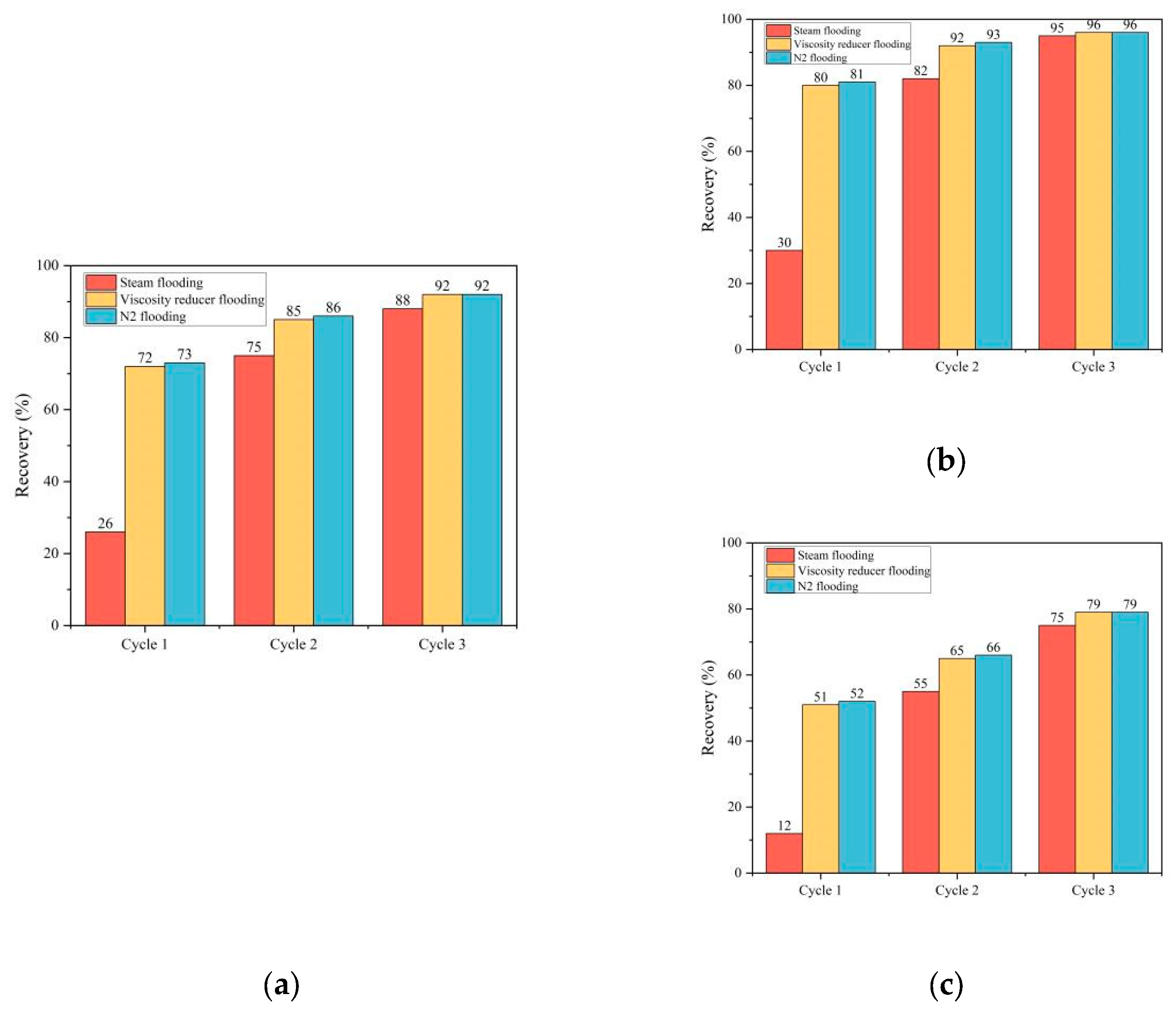
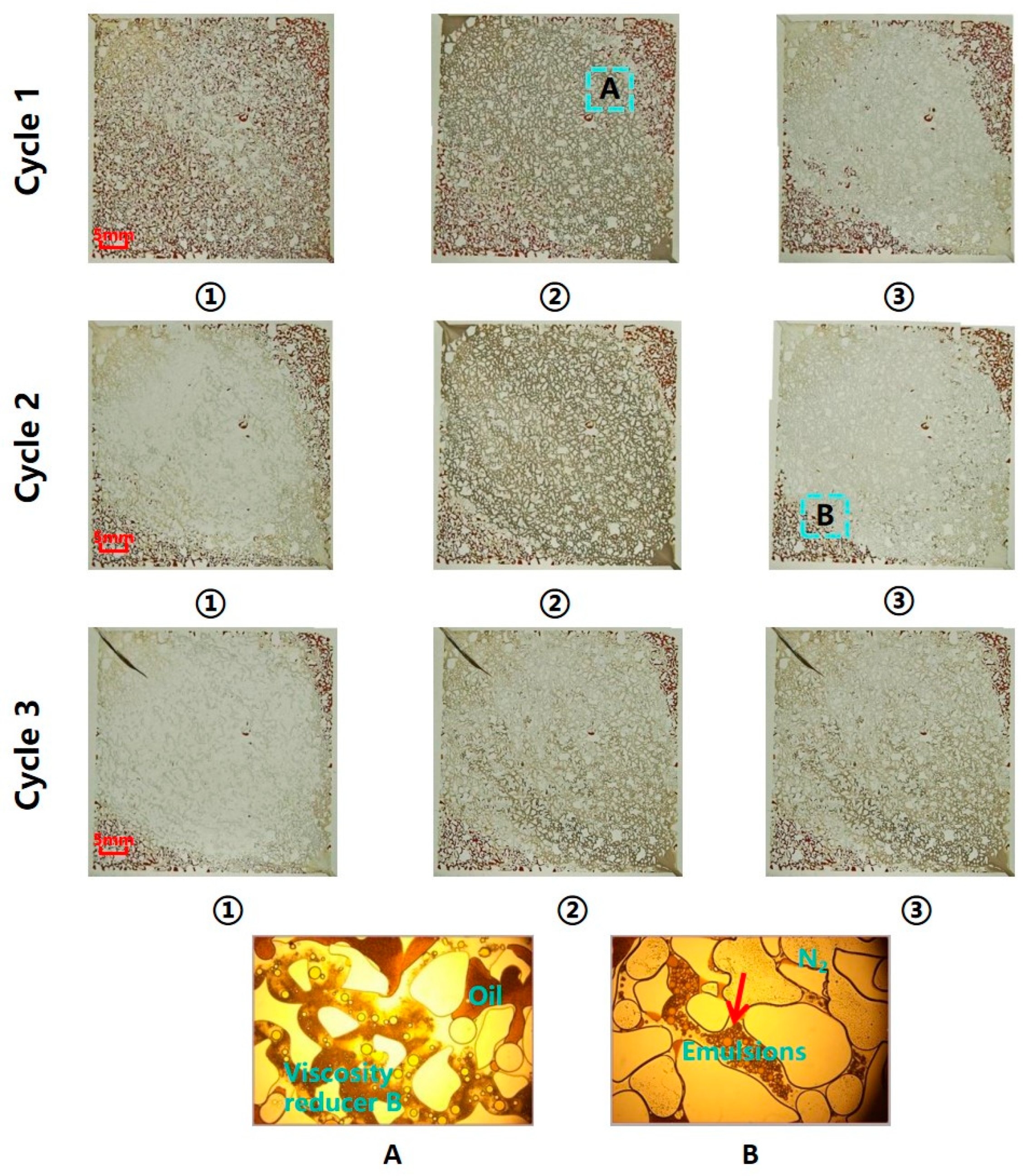
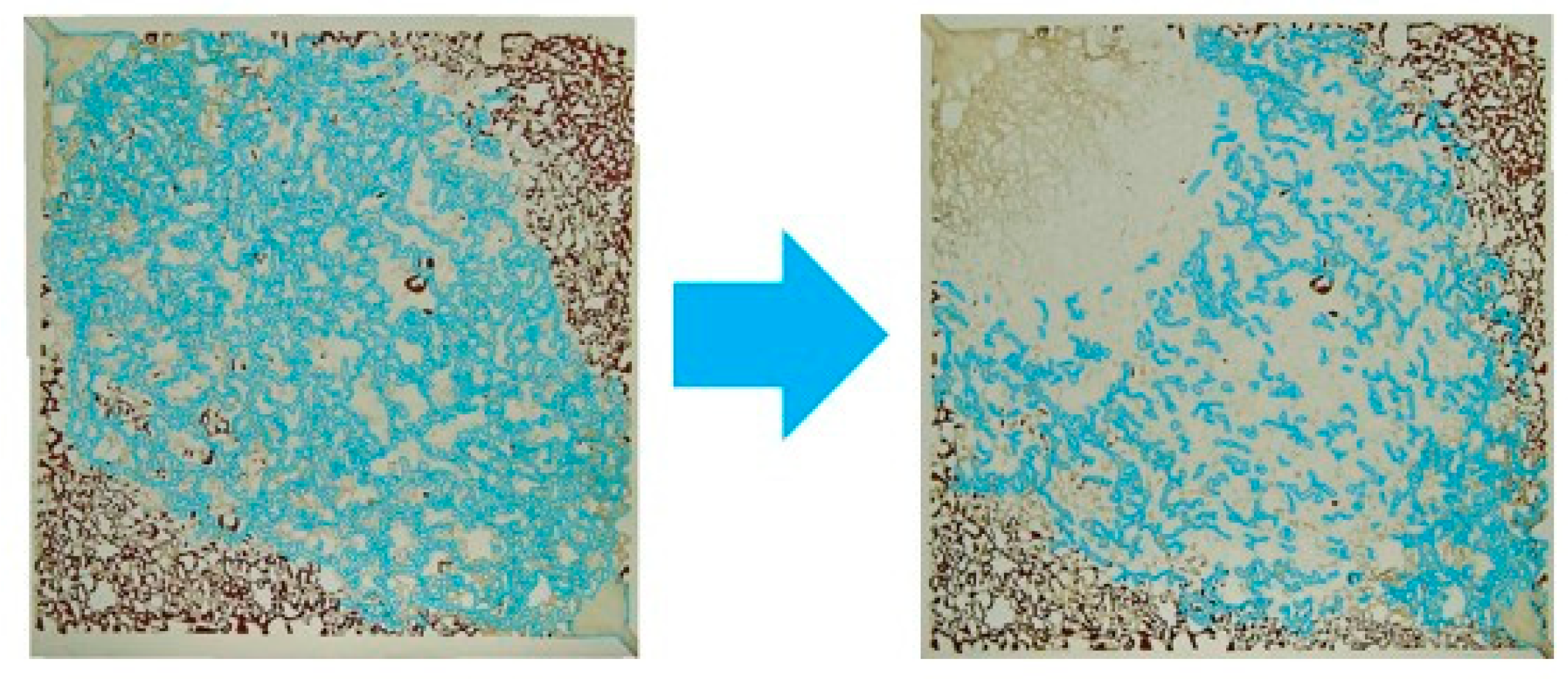
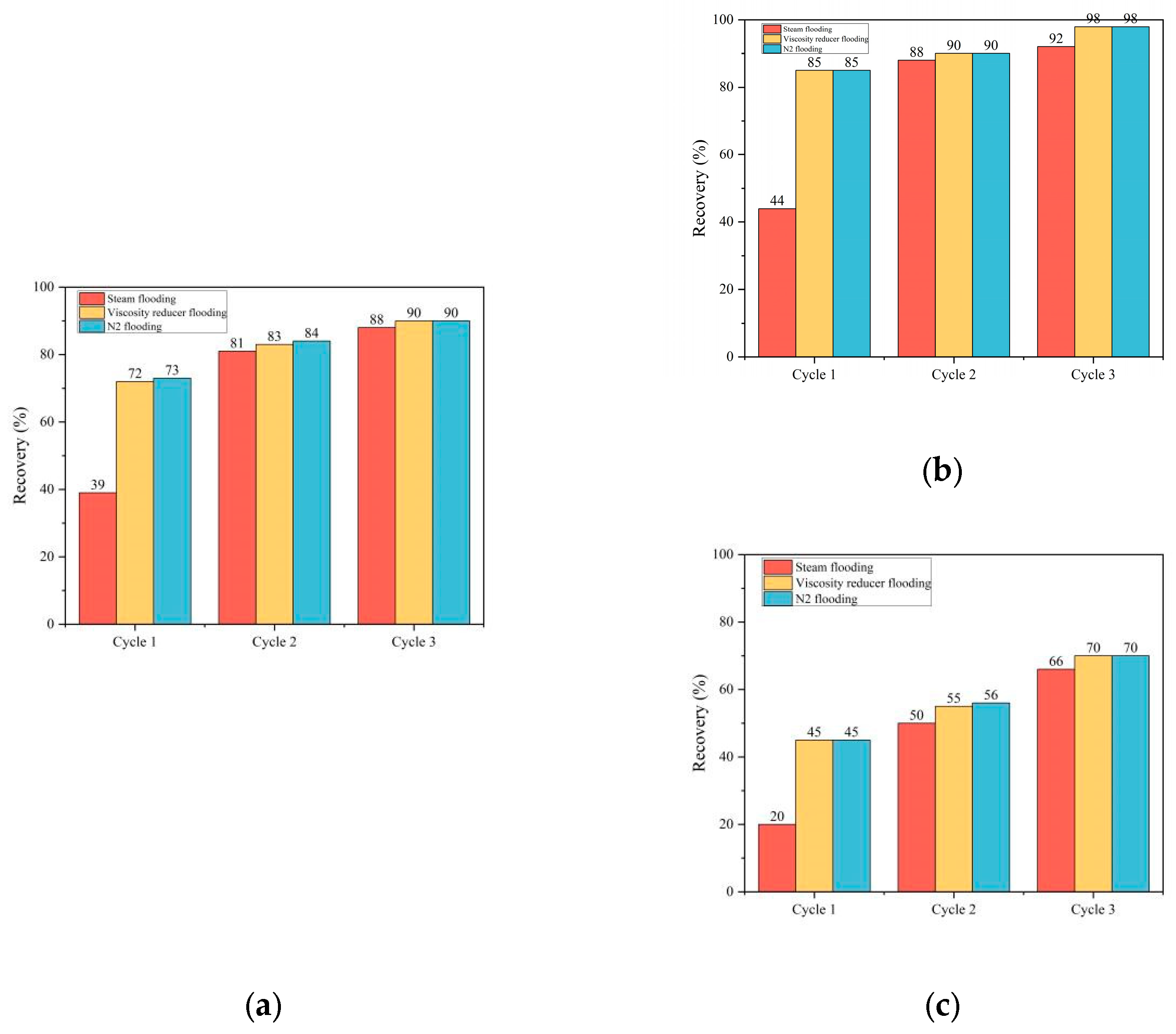


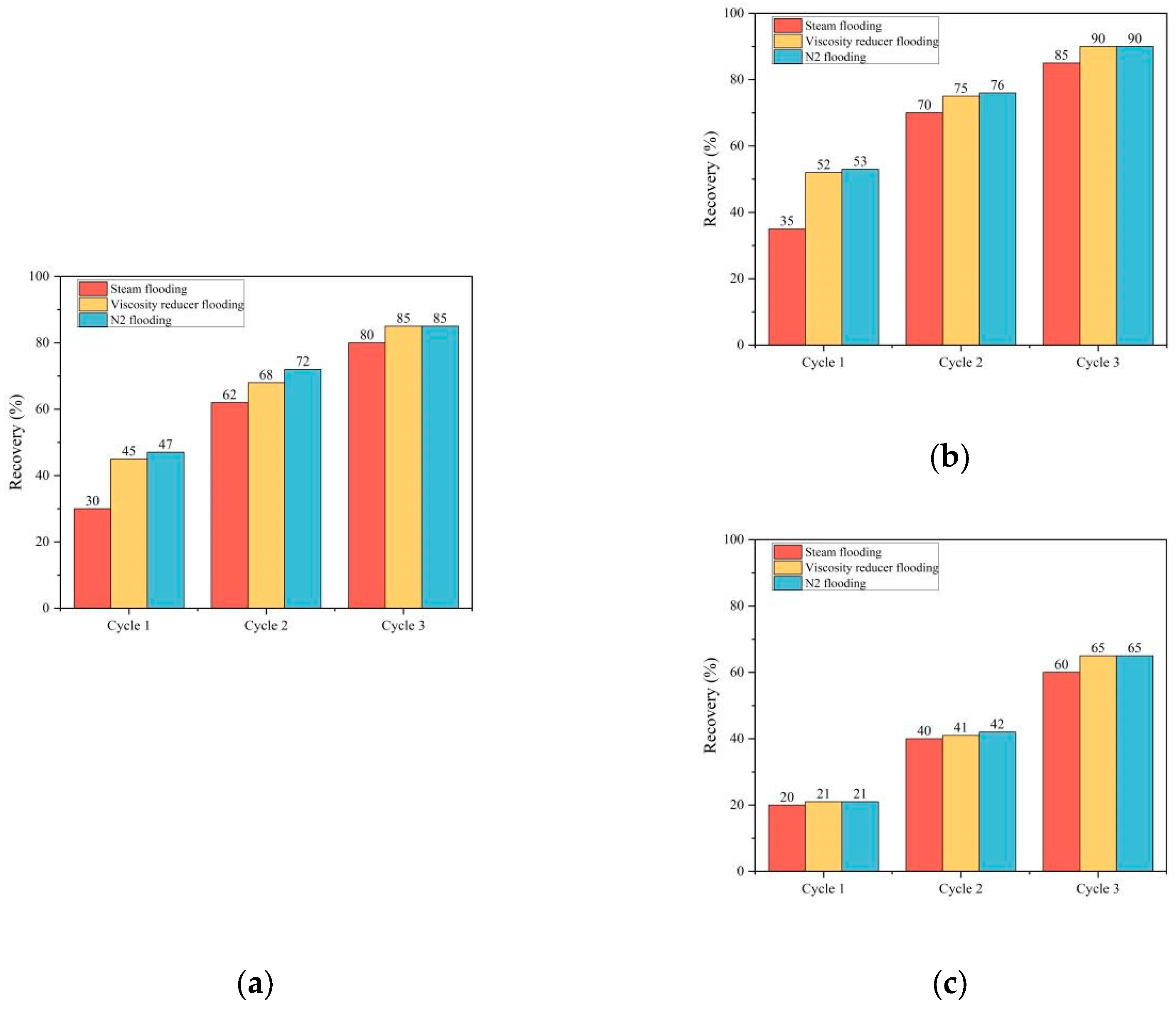
Disclaimer/Publisher’s Note: The statements, opinions and data contained in all publications are solely those of the individual author(s) and contributor(s) and not of MDPI and/or the editor(s). MDPI and/or the editor(s) disclaim responsibility for any injury to people or property resulting from any ideas, methods, instructions or products referred to in the content. |
© 2024 by the authors. Licensee MDPI, Basel, Switzerland. This article is an open access article distributed under the terms and conditions of the Creative Commons Attribution (CC BY) license (https://creativecommons.org/licenses/by/4.0/).
Share and Cite
Zhang, B.; Song, Z.; Zhang, Y. Pore-Scale Mechanism Analysis of Enhanced Oil Recovery by Horizontal Well, Dissolver, Nitrogen, and Steam Combined Flooding in Reducer Systems with Different Viscosities for Heavy Oil Thermal Recovery. Energies 2024, 17, 4783. https://doi.org/10.3390/en17194783
Zhang B, Song Z, Zhang Y. Pore-Scale Mechanism Analysis of Enhanced Oil Recovery by Horizontal Well, Dissolver, Nitrogen, and Steam Combined Flooding in Reducer Systems with Different Viscosities for Heavy Oil Thermal Recovery. Energies. 2024; 17(19):4783. https://doi.org/10.3390/en17194783
Chicago/Turabian StyleZhang, Bowen, Zhiyong Song, and Yang Zhang. 2024. "Pore-Scale Mechanism Analysis of Enhanced Oil Recovery by Horizontal Well, Dissolver, Nitrogen, and Steam Combined Flooding in Reducer Systems with Different Viscosities for Heavy Oil Thermal Recovery" Energies 17, no. 19: 4783. https://doi.org/10.3390/en17194783





